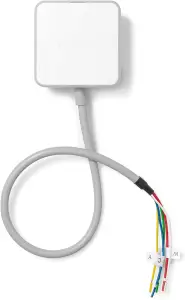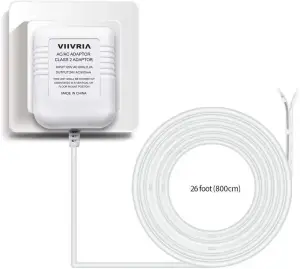Your newly purchased thermostat needs a C-wire but you’ve now discovered that your HVAC system doesn’t have a C-wire. However, according to the thermostat’s manual, it can work with a C-wire adaptor. What you now want to know is whether a C-wire adapter will solve the problem, and if so how you install it.
So, what is a C wire adapter?
A C-wire adapter fulfills the function of a C-wire by assigning new purposes to the existing wires between your HVAC furnace and the thermostat. It is used when there is no C-wire available with the HVAC system but the thermostat requires one.

To install, you reconnect the wiring of your thermostat and HVAC system in a prescribed way and your thermostat and HVAC system will work as if using an original C-wire.
In this article, I’ll explain how to install a C-wire adapter. Although some thermostat brands and models might have more model-specific ways of installation, the explanation in this article will enable you to understand the basic principles. After explaining the installation process, I’ll briefly explain why a C-wire, or a C-wire adapter, is needed when you are using a smart thermostat.
How to install a C-wire adapter
When I explain how to install a C-wire adapter, you’ll also get an understanding of how it works. The important aspect you should always remember is that, in principle, you use a C-wire adapter to assign new purposes to the existing wires between your HVAC’s furnace and the thermostat to take over the function of a not existing C-wire. And this re-purposing is needed to ensure that your thermostat is receiving 24 volts power 24/7.
To install a C-wire adaptor, you will have to make some wiring changes at the thermostat and other changes at the furnace circuit board. Because you are going to work with wires carrying power, ensure that you cut off the power before opening the thermostat or the furnace circuit board. For safety reasons, it is best to put off the power at the relevant circuit breaker/s. Usually, it is only one circuit breaker you have to put off, but the power to your HAVC devices and thermostat might be routed through different circuit breakers. If that is the case, put off all the relevant breakers.
After the power has been put off, follow the following procedure to install the adapter.
Step 1: Remove the face plate of the thermostat
Remove the face plate of the thermostat from the wall. Usually, most thermostats can be removed from the wall by just delicately pulling the face off the wall plate, but with some models, you’ll have to remove a screw or release a catch. Ensure that you don’t disconnect any wiring when you remove the thermostat’s face plate. To help you later refer to your original thermostat wiring if you had to, it is good practice to take a photo of the wiring on the thermostat before you make any changes.
Step 2: Confirm that you don’t have a C-wire
Confirm that you don’t have a wire in the thermostat’s C-terminal. If there is a wire connected to the C-terminal, you don’t need a C-wire adapter – the thermostat is already connected to a continuous power supply.
Step 3: Open your system’s control board
Also, open your HVAC system’s cover (usually located on the furnace) to reveal the control board and take a picture of the wires on the control board as well for possible later reference.
Step 4: Label, disconnect wiring from the control board, and connect to the adapter
Clearly label the following connected wires connected to the control board. G, W (or W1), R (or Rc), Y (or Y1) and then disconnect them from the control board. Insert these disconnected wires into the C-wire adapter as follows:
- Wire marked “W” to the W-terminal of the adapter
- Wire marked “G” to the C-terminal on the adapter
- Wire marked “Y” to the K-terminal on the adapter
- Wire marked ”R” to the R-terminal on the adapter
Take a photo of the wired adapter for possible later reference.
Step 5: Connect wires to the control board
Connect the wires labeled on the other side of the adapter to the matching terminals on the control board. When all the connections have been made, place the adapter between your thermostat wiring and the control board and close the control board.
Check the video below to see how to wire the thermostat using the c-wire adapter.
Step 6: Complete the connections at the thermostat
Go back to the thermostat and connect the R-wire coming from the wall to the thermostat’s RC terminal. Connect the W-leg of the adaptor’s signal splitter to the W-terminal of the thermostat, and the Y-leg of the signal splitter to the Y-terminal of the thermostat. Disconnect the G-wire and connect it to the C-terminal of the thermostat.
Step 7: Finishing touches
Fit the wires in the rear of the thermostat, and press the thermostat into place on the mounting plate. Turn the circuit breaker/s on again. You’ve successfully installed your C-wire adapter for your thermostat.
The purpose of a C-wire
Now that you know how a C-wire adapter works and how to install it, you may wonder whether it is really necessary to have a C-wire or C-wire adapter for your HVAC system. Let’s briefly discuss this.
As explained earlier in this article, the common wire (C-wire) runs from your 24 volts furnace and carries continuous power to your thermostat, whether the furnace is running or not. Originally thermostats didn’t need continuous power because they were, in principle, only used as an on/off switch for the air conditioner and/or furnace. They had no function when the cooling or heating system was not running. Thus, they only need and receive power when either the cooling or heating system was in use.
Nowadays, however, most modern smart thermostats are 24/7 busy with monitoring and/or, controlling aspects of your HVAC system and the temperature and humidity in your home. To be able to function day and night, the thermostat is using power, whether the cooling or heating system is running or not. Therefore modern smart thermostats require a continuous 24 volts power supply.
Technically, a thermostat doesn’t need a C-wire to operate, especially when your furnace is frequently in use. While the furnace is in use your thermostat is receiving power and its internal battery can be charged. The problem, however, is that when your furnace is for long periods not active, the thermostat’s battery becomes depleted and the thermostat stops working.
The common wire (C-wire) provides the thermostat with a 24 volts AC supply continuously even when neither the cooling nor heating system is running.
Difference between a C-wire adapter and a thermostat power connection/transformer
Sometimes, homeowners confuse a C-wire adapter with a thermostat power connection/transformer. They are two different types of devices and are installed and used differently. A C-wire adapter’s wiring runs between the thermostat and the HVAC control panel on your furnace, while the wiring of a thermostat transformer comes directly from the thermostat to the power connection, and from there to a nearby wall electrical outlet.
Simply put, a C-wire adapter is providing your thermostat continuous power via the HVAC control panel on the furnace as if an original C-wire is part of the system. Thus, when a C-wire adapter is installed, you can forget about it – it doesn’t need special maintenance or a wall power outlet to function.
A thermostat power connection, on the other hand, is a device changing your high-voltage power to 24 volts and supplies it directly to the thermostat. It is easy to connect to your thermostat but you must have an electric outlet on the wall near the thermostat.

Another con of a power connection is that the wires from the wall outlet to the connector and the thermostat are running at the outside of your wall. You can also unintentionally switch off the outlet and no power will then be supplied to the thermostat.
FAQs
Q1: Can I use the G-wire to create a C-wire?
A1: Yes, you can use the G-wire which is the wire controlling the blower fan manually. If you connect the G-wire with the C-wire terminal, you’ll have a C-wire installed.
Q2: Can I install a new C-wire in my home instead of using a C-wire adapter?
A1: Yes, an HVAC technician can install a new C-wire between your thermostat and the HVAC control panel. This is a more expensive option than installing a C-wire adapter because, generally speaking, it is not a DIY job.
Conclusion
Most smart thermostats need a continuous 24 volts power provision and if your HVAC system doesn’t have a C-wire your thermostat’s battery might be drained when the furnace is not working frequently enough. The problem will be solved if you install a C-wire adapter.

